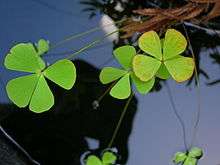Marsilea
| Marsilea | |
|---|---|
 | |
| Marsilea villosa | |
| Scientific classification | |
| Kingdom: | Plantae |
| Division: | Pteridophyta |
| Class: | Polypodiopsida / Pteridopsida (disputed) |
| Order: | Salviniales |
| Family: | Marsileaceae |
| Genus: | Marsilea[1] L. |
| Species | |
|
See text. | |
| Synonyms | |
|
Lemma Juss. ex Adans. | |
Marsilea is a genus of approximately 65 species of aquatic ferns of the family Marsileaceae. The name honours Italian naturalist Luigi Ferdinando Marsigli (1656–1730).[3]
These small plants are of unusual appearance and do not resemble common ferns. Common names include water clover and four-leaf clover because the long-stalked leaves have four clover-like lobes and are either held above water or submerged.
The sporocarps of some Australian species are very drought-resistant, surviving up to 100 years in dry conditions. On wetting, the gelatinous interior of the sporocarp swells, splitting it and releasing a worm-like mass that carries sori, eventually leading to germination of spores and fertilization.
Uses
.jpg)
As food
Sporocarps of some Australian species such as Marsilea drummondii are edible and have been eaten by Aborigines and early white settlers, who knew it under the name ngardu or nardoo. Parts of Marsilea drummondii contain an enzyme which destroys thiamine (vitamin B1), leading to brain damage in sheep and horses. During floods in the Gwydir River basin 2,200 sheep died after eating nardoo. Three-quarters of the sheep that were affected did however respond to thiamine injections.[5] Thiamine deficiency from incorrectly prepared nardoo likely resulted in the starvation and death of Burke and Wills.[6][7]
The leaves of Marsilea crenata are part of the East Javanese cuisine of Indonesia, especially in the city of Surabaya. It is called Pecel Semanggi and is served with spicy peanut and sweet potato sauce.
Ornamental
A few species in the genus, such as Marsilea crenata, Marsilea exarata, Marsilea hirsuta, and Marsilea quadrifolia, are grown in aquaria.
Selected species
|
|
Formerly placed here
- Salvinia natans (L.) All. (as M. natans L.)[8]
See also
References
| Wikimedia Commons has media related to Marsilea. |
| Wikispecies has information related to: Marsilea |
- ↑ C.Michael Hogan. 2010. Fern. Encyclopedia of Earth. eds. Saikat Basu and C.Cleveland. National Council for Science and the Environment. Washington DC.
- ↑ "Genus: Marsilea L.". Germplasm Resources Information Network. United States Department of Agriculture. 2007-10-05. Retrieved 2010-07-13.
- ↑ "Marsilea Linnaeus, Sp. Pl. 2: 1099. 1753; Gen. Pl. ed. 5, 485, 1754.". Flora of North America. eFloras.org. Retrieved 2013-04-14.
- ↑ Schaefer, Hanno; Mark A Carine; Fred J Rumsey (October–December 2011). "From European priority species to invasive weed: Marsilea azorica is a misidentified alien". Systematic Botany 36 (4): 845–853. doi:10.1600/036364411X604868.
- ↑ Watt, Bruce, Managing the land – Toxic Plants, Pro Grazier, Winter, 2009, MLA
- ↑ Chaffey, Calder (June 2002). "A Fern which Changed Australian History". Australian Plants Online. Association of Societies for Growing Australian Plants. Retrieved 2013-04-14.
- ↑ Phoenix, Dave (2011). "Did Burke and Wills die because they ate nardoo?". State Library of Victoria: The Burke & Wills research gateway.
- 1 2 "GRIN Species Records of Marsilea". Germplasm Resources Information Network. United States Department of Agriculture. Retrieved 2010-07-13.
- Mabberley, D.J. (1997). The Plant-Book. Cambridge University Press.
- Edmund Russow: Histologie und Entwicklungsgeschichte der Sporenfrucht von Marsilia. Dissertation. Dorpat 1871 (PDF)
- Johnson 1986 Systematics of the New World species of Marsilea. Syst. Bot. Monog. 11:1–87.
- World species list for Marsilea